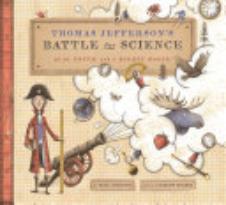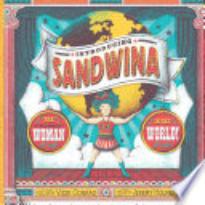Jeremy Holmes
8 Reviews
(1)
K-3
Illustrated by
Jeremy Holmes.
As a product of the Age of Reason, Thomas Jefferson was long fascinated by science in general and the natural world in particular. Consequently, when he first read a French encyclopedia by the renowned scientist Comte de Buffon that declared the American colonies inferior because the native animals were neither as large nor as ferocious as their European counterparts, Jefferson questioned Buffon's reasoning -- partly because of the audacious comments, partly because of national pride, and partly because Jefferson did not want to discourage immigration. For years he challenged these assumptions by asking questions; creating counterarguments; conducting experiments (which included the shipping of a dead moose to France to verify its large size); and formulating and publishing his conclusions. In other words, he followed the scientific method, nicely summarized in the back matter. The mixed-media illustrations, crafted with woodblocks and pencil, are highlighted in unusual and effective layouts. The written narrative appears in text boxes, acting either as previews for the often-humorous illustrations (for example, ideas explode from Jefferson's head as he writes his own book challenging Buffon) or as comic panels. A concluding author's note explains the sources and dangers of misinformation and ways to identify and combat such rumors, as well as a timeline of Jefferson's life and a bibliography -- appropriately, for the topic -- divided into primary and secondary sources.
Reviewer: Betty Carter
| Horn Book Magazine Issue:
May, 2024
(2)
K-3
Illustrated by
Jeremy Holmes.
Born into a German circus family in 1884, Katie Brumbach dazzled audiences with incredible feats of strength. Conrad opens her tale with Brumbach's legendary win over strongman Eugen Sandow, after which she renamed herself Sandwina. (The author says in her closing note that there is no written record of the victory but: "This legend has been told over and over again.") Readers learn of Sandwina's romance with a skinny acrobat named Max who became her husband -- and stage prop -- and of their immigration to the United States and her subsequent career. Conrad adopts the tone of a carnival barker to reel off her subject's many feats of strength: "Sandwina balanced a 1,000-pound cannon on her chest. When eight men placed a half-ton stone onto Sandwina's back, she threw it off!" Holmes matches Conrad's delivery with a poster-inspired design that leans into Sandwina's charismatic stage presence, topping her burly form with a pile of blue, curlicued tresses, and is complemented by flourishes of display type (which sometimes threaten to overwhelm the narrative). Occasional ticket-shaped callout boxes convey additional information, such as the fact that Sandwina and other circus women joined the suffrage movement. Beneath Conrad's breathless narration runs a strong current of body positivity: "Sandwina proved strength was beauty, and beauty was strength. Katie's bold costumes showed off every muscle." Photographs accompanying the back matter back this claim up. A rousing introduction to a larger-than-life figure.
Reviewer: Vicky Smith
| Horn Book Magazine Issue:
January, 2025
(3)
4-6
Secrets of the Dragon Tomb series.
Illustrated by
Jeremy Holmes.
In Lunae City on 1817 British Mars, Edward spots a thief leaving Lady Harleston's townhouse, throwing him and younger sister Putty into a twisty mystery. Best enjoyed in series order (The Secrets of the Dragon Tomb), this second adventure boasts a complex story arc, inventive clockwork mechanics, and intriguing alternate history of space colonization. Occasional full-page illustrations play up the steampunk.
Reviewer: Jessica Bushore
(3)
4-6
Illustrated by
Jeremy Holmes.
A magical Romani trombone whisks twelve-year-olds Bro, Frankie, and Tom back to 1852 in their small Ohio town, a dangerous era for the three nonwhite kids as they are targets for slave traders. An ancient Chinese text and Morse code messages may help get them back. This original, humorous adventure novel is great fun for fans of history and time travel.
Reviewer: Pam Yosca
(3)
4-6
Illustrated by
Jeremy Holmes.
During a tremendous storm, twelve-year-old twins Fenton and Fiona find a ball of light with the power to restore life to the dead--sort of. They experiment on the deceased family dog before moving on to digging up their grandfather, with mixed results. This comic science-fiction romp explores themes of ethical science experimentation and family forgiveness. Field guide–style illustrations appear throughout.
Reviewer: Lisa Catherine Findlay
(3)
K-3
Illustrated by
Jeremy Holmes.
Why should cars be limited to steel and glass? These two dozen short poems offer vehicle lovers delightful automobile alternatives with distinct advantages: e.g., the paper car ("if it breaks down, don't frown, just...quickly shred it") or the hot-dog car ("you just can't beat it. / And when you're done / You simply eat it"). Holmes's subdued-palette, retro illustrations extend the humor.
Reviewer: Patricia Riley
(3)
4-6
Templeton Twins series.
Illustrated by
Jeremy Holmes.
The Templeton siblings' second adventure (The Templeton Twins Have an Idea) finds John and Abigail facing off against the villainous Dean D. Dean. This time Dean is trying to take credit for Professor Templeton's new invention: a device to show close-ups of actors onstage. The first book's formula of puns, puzzles, intrusive narrator (and snarky footnotes), and blue-inked digital illustrations is effectively repeated here.
Reviewer: Elissa Gershowitz
(2)
4-6
Templeton Twins series.
Illustrated by
Jeremy Holmes.
Thirteen-year-old twins John and Abigail's inventor/professor father has a new job at Tick-Tock Tech. There, twins Dean D. Dean (an angry former student) and Dan D. Dean kidnap the sibs; luckily, the kids' hobbies--cryptic-crossword-solving and drum-playing--come in handy. A direct-address narrator relates events, provides commentary, and poses satiric questions; digital illustrations and faux-scientific diagrams play up the story's humor.
Reviewer: Elissa Gershowitz
| Horn Book Magazine Issue:
September, 2012
8 reviews
We are currently offering this content for free. Sign up now to activate your personal profile, where you can save articles for future viewing.












